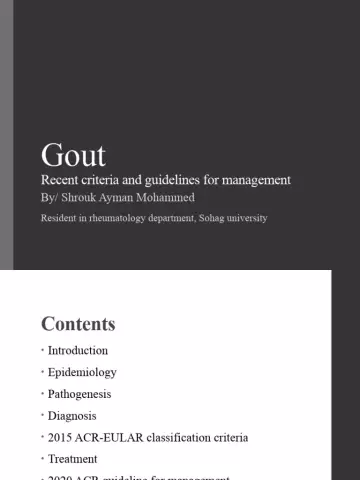- Author Curtis Blomfield [email protected].
- Public 2024-01-02 05:35.
- Last modified 2025-01-23 17:01.
Gout occurs when purine metabolism is disturbed in the human body. At the same time, an overestimated concentration of uric acid is found in the blood, and articular and / or periarticular tissues, kidneys and other organs suffer from deposits of urate - sodium urate s alts.
Causes of gout
Excess uric acid is formed under the influence of increased synthesis of endogenous purines, reduced excretion of urates, or a combination of these processes. Recognize the symptoms of primary and secondary disease. The latter case obliges to pay attention to the medicines taken by a person who is struck by gout. The causes of the disease require detailed consideration.
Gout due to overproduction of uric acid

An excess of purine bases and nucleosides is the main reason for the high concentration of uric acid. With unlimited consumption of food, which contains abundant purine-forming substrates, overproduction of acid naturally occurs.
Symptoms of secondary hyperproduction are caused by excessively high cell breakdown occurring against the background of certain diseases (for example, hemoblastosis, paraproteinemia, hemolysis,alcoholism, cancer chemotherapy). Hyperuricemia often accompanies psoriasis. However, the clinical pathology of gout in these cases develops infrequently.
Gout due to decreased excretion of uric acid
90% of people who are burdened with gout disease have reduced acid extraction. The kidneys, intestines and skin help to leave the body of uric acid. With reduced excretion of urates by the kidneys, they accumulate in excess in the body and crystallize. Tiny crystals are deposited in the joints, leading to inflammation and pain. And the kidneys are affected by urate nephritis.
This phenomenon is sometimes caused by diuretics, alcohol, acetylsalicylic acid, aminophylline, caffeine, diazepam, diphenhydramine, L-dopa, dopamine, vitamins B12 and C in small doses. Lead leads to epidemic outbreaks. Lead gout is caused by paints, surrogate alcohol and other sources containing heavy metal.
Gout symptoms: signs of attacks
The occurrence of symptoms is associated with deposits of s alts formed by uric acid. Crystals settle in the joints and kidneys. The first attack of gout usually does not occur before the age of thirty. It is experienced more often by patients who have reached the age of 40-60.
The attack is accompanied by swelling and redness of the joint, acute pain. Without treatment, it does not go away for several days and even weeks. Evening and night are the main times for the onset of transient seizures.

A gout attack is provoked by a rich meat diet,alcoholic beverages, certain varieties of fish, coffee and other products enriched with purine bases. The disease in most cases affects the big toe, although damage to other joints is not at all excluded. Its striking symptom is acute arthritis, which unfavorably proceeds with kidney pathologies.
Acute gout
Arthritis is an acute form of gout. It is expressed in a sudden attack of gout - a painful inflammation of the joint. In gouty arthritis, urate crystals fall out of the tissues into the joint cavity, causing inflammation. Gout attacks usually occur in the middle of the night.
Provoked by alcohol, trauma, physical overload, surgery, a number of medications gout. Treatment with medicines can relieve seizures and alleviate the condition. During attacks, the joint and adjacent tissues swell, the skin at the site of the focus turns red, pain increases.
Acute arthritis attacks disappear within a few days (sometimes weeks), even if they are not treated. Repeated attack returns after six months or a year. Although periods of calm sometimes last up to 10-20 years. In people who are not puzzled by treatment, the frequency of attacks increases, several joints are involved in them at the same time. The duration of the attacks increases, they become more pronounced.

Chronic gout
The chronic course of the disease is accompanied by characteristic signs:
- chronic arthritis;
- accumulation of urate crystals;
- kidney damage.
Long-term gout is accompanied by all the symptoms at the same time. Chronic arthritis affects those who have survived the secondary form of the disease, untimely or inadequately treated.
When the kidneys are affected, there are 3 types of changes:
- Kidney tissue overgrown with urate crystals. A mild inflammatory reaction flows in them.
- Intrarenal urinary tract clogged with urate crystals.
- Uric acid stones have formed in the urinary tract.
Modifications are combined in various variations, resulting in the clinical term "gouty kidney". Stones in the urinary tract may be asymptomatic or show signs of urolithiasis.
Treatments
The goal of treatment is to prevent gout attacks and relieve acute arthritis. By maintaining an adequate drinking regimen, losing excess weight, diet therapy, reducing drugs that increase hyperuricemia, and eliminating alcohol, gout is prevented. Medication treatment can eliminate inflammation and pain.
Water reduces the concentration of urates, preventing them from falling into crystals that settle in tissues and organs. In addition, it contributes to their leaching and removal from the body. Alcohol is capable of a diuretic effect. In large doses, it dehydrates the body, contributing to the crystallization of s alts, initiating gouty attacks. In addition, it slows down the excretion of urates from the body, giving them the opportunity to be deposited in the joints.
Weight loss helps reduce the risk of recurrent goutyseizures. The diet should reduce fat and reduce calories. The diet is combined with regular aerobic exercise.
Drug therapy

The main aspects by which gout is controlled are treatment with drugs that relieve pain, eliminate inflammatory reactions, control the disturbed metabolism, leading to hyperuricemia. Anesthesia is carried out with acetaminophen (Tylenol) or other more powerful analgesics.
Of the non-steroidal anti-inflammatory drugs, indomethacin is recommended. True, it is not suitable for patients with allergies to aspirin and patients with nasal polyps. Colchicine is suitable for relieving a gouty attack.
Patient reviews emphasize that oral medication has serious side effects associated with the frequency of its use (once an hour or two hours until the pain subsides significantly or adverse reactions appear).

Corticosteroids, a powerful anti-inflammatory agent, relieve acute attacks. In order to avoid severe long-term side effects, they are prescribed in short courses. They are prescribed to patients with concomitant diseases of the liver and kidneys.
For long periods, patients take drugs that reduce the concentration of uric acid in the blood. They contribute to the dissolution of heavy tofus deposits, prevent stone formation and the development of pathologies in the kidneys. Thanks to them, gout does not recur. Treatmentdrugs from this category either increase the excretion of urates or reduce their synthesis from food purines.
These drugs can worsen a gouty attack, so they are taken after the inflammatory process has subsided. If they were treated before an attack, the course is not interrupted, but they try to adjust the dosage (especially after its extinction). Because many patients with high uric acid levels do not develop kidney stones or suffer from gout, medications that affect urate levels are highly individualized.
With the help of probenecid and sulfinpyrazone, they increase the excretion of uric acid. These drugs are not suitable for the treatment of people with urolithiasis. They sometimes provoke the formation of stones. Drinking plenty of water, combined with their intake, promotes an accelerated passage of acid through the urinary system and prevents the formation of conglomerates.
Thanks to allopurinol prevent the synthesis of uric acid. They block the metabolic conversion of purine bases into acids. It is cautiously prescribed due to the risk of side effects in those with impaired kidney function.
Using home remedies
Home treatments help to relieve the symptoms of acute gout. The inflamed joint is lifted up, providing it with peace. Pain is relieved by applying ice. Avoid taking aspirin-containing drugs (they inhibit the excretion of uric acid).
They are treated with medicinal plants: rose hips and sea buckthorn, lingonberries andstrawberries, mountain ash and blueberries, barberry and St. John's wort, birch and linden, chicory and other herbs. They use homeopathic remedies.

Diet therapy for gout
Compliance with the diet provides a stable remission. Ideally, complete elimination of purine-fortified foods is achieved. If an absolute exclusion is not possible, a maximum restriction on their consumption is introduced. They try to balance the amount of fat and drink plenty.
Anchovies, sardines, goose, chicken and any fatty meat, offal, meat extracts, legumes and dry wine are rich in purines. When diagnosed with gout, tomatoes are eaten in moderation.

Tomatoes are full of organic acids. There are not as many purines in them as, for example, in meat. Therefore, nutritionists do not prohibit those who suffer from gout from eating tomatoes. On the contrary, they believe that a reasonable amount of tomatoes and dishes from them is good for such patients.






